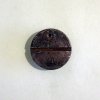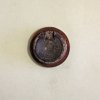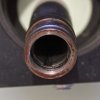The attached images are of an unknown 1” projectile. As can be seen from the markings it is 1” calibre, was made by Vickers Sons and Maxim on 16th August 1916 and made from Forged Steel. The markings on the opposite side are ‘N’ presumably indicating Naval service, it’s not where you would normally expect a Naval identifier, however space is at a premium on a projectile this side. Underneath the ‘N’ is a Broad Arrow. Beneath the driving band is L 2, the assumption here is that this means Lot 2 having been abbreviated due to space constraints. There are no less than four inspection marks on the projectile body.
Screwed into the base of the projectile is a slotted plug (LH thread)whilst not particular visible in image three, there is a plug in the 12 o/clock position which is essentially a piece of thick wire that has had the end peened over. Image 4 shows this plug removed.
On inverting the slotted plug one can see a small brass insert that has a very small hole in it. The hole appears to be a couple of millimetres deep. There is also a copper washer on the slotted plug.
The projectile has a cavity that extends almost the full length. There are two diametrically opposed slots that have been broached into the inside projectile wall and extend about half the length of the projectile. The slots are 0.150” wide and about 0.025” deep at the start and taper out. The cavity has an aromatic smell, not too dissimilar to Eucalyptus oil. One of the slots is just about visible in Image 4
This would appear to be a ‘Day Tracer’ the cavity being filled with a liquid or semi-liquid that was expelled through the orifice in the base. Similar in function to “Shell Q.F., H.E.and Day Tracer 3 inch, 20 & 10 cwt.
The only 1" weapon of the time that I can find is the 1" Aiming Rifle and in Peter Labbett's book - "British Small Arms 1864-1938 (other than 303 inch calibre)", he makes mention of two steel projectiles that were accepted into service for the 1" Aiming Rifle in late 1915. Of the two projectiles, one has a totally different profile and the other, which was a tracer round, was nothing more than a solid projectile with a very generous pyrotechnic tracer inserted in the base.
If this was for the 1” Aiming Rifle it seems to be very over engineered.
The last two images are of the Vickers 25.4 x 112R between wars experimental round. The projectile of which one can see bears a very strong resemblance to the detailed projectile, although the placement of cannelure is different. It could well be that VSM had left over projectiles/tooling from the 1916 contract, but why did they include the screw in plug and copper washer?
For further reading on Vicker 1” ammunition see http://www.quarryhs.co.uk/Vickers25.4.htm
If anyone can shed any further information on the detailed projectile, I would be most grateful to hear.
TimG








Screwed into the base of the projectile is a slotted plug (LH thread)whilst not particular visible in image three, there is a plug in the 12 o/clock position which is essentially a piece of thick wire that has had the end peened over. Image 4 shows this plug removed.
On inverting the slotted plug one can see a small brass insert that has a very small hole in it. The hole appears to be a couple of millimetres deep. There is also a copper washer on the slotted plug.
The projectile has a cavity that extends almost the full length. There are two diametrically opposed slots that have been broached into the inside projectile wall and extend about half the length of the projectile. The slots are 0.150” wide and about 0.025” deep at the start and taper out. The cavity has an aromatic smell, not too dissimilar to Eucalyptus oil. One of the slots is just about visible in Image 4
This would appear to be a ‘Day Tracer’ the cavity being filled with a liquid or semi-liquid that was expelled through the orifice in the base. Similar in function to “Shell Q.F., H.E.and Day Tracer 3 inch, 20 & 10 cwt.
The only 1" weapon of the time that I can find is the 1" Aiming Rifle and in Peter Labbett's book - "British Small Arms 1864-1938 (other than 303 inch calibre)", he makes mention of two steel projectiles that were accepted into service for the 1" Aiming Rifle in late 1915. Of the two projectiles, one has a totally different profile and the other, which was a tracer round, was nothing more than a solid projectile with a very generous pyrotechnic tracer inserted in the base.
If this was for the 1” Aiming Rifle it seems to be very over engineered.
The last two images are of the Vickers 25.4 x 112R between wars experimental round. The projectile of which one can see bears a very strong resemblance to the detailed projectile, although the placement of cannelure is different. It could well be that VSM had left over projectiles/tooling from the 1916 contract, but why did they include the screw in plug and copper washer?
For further reading on Vicker 1” ammunition see http://www.quarryhs.co.uk/Vickers25.4.htm
If anyone can shed any further information on the detailed projectile, I would be most grateful to hear.
TimG







